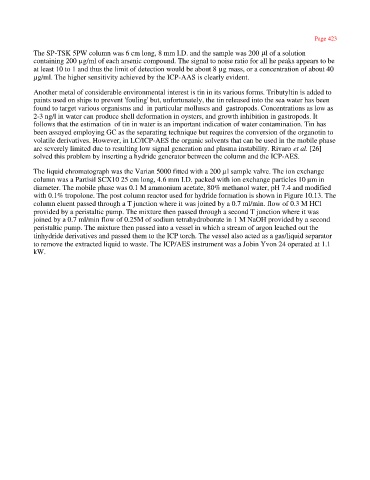Page 440 - Tandem Techniques
P. 440
Page 423
The SP-TSK 5PW column was 6 cm long, 8 mm I.D. and the sample was 200 ml of a solution
containing 200 µg/ml of each arsenic compound. The signal to noise ratio for all he peaks appears to be
at least 10 to 1 and thus the limit of detection would be about 8 µg mass, or a concentration of about 40
µg/ml. The higher sensitivity achieved by the ICP-AAS is clearly evident.
Another metal of considerable environmental interest is tin in its various forms. Tributyltin is added to
paints used on ships to prevent 'fouling' but, unfortunately, the tin released into the sea water has been
found to target various organisms and in particular molluscs and gastropods. Concentrations as low as
2-3 ng/l in water can produce shell deformation in oysters, and growth inhibition in gastropods. It
follows that the estimation of tin in water is an important indication of water contamination. Tin has
been assayed employing GC as the separating technique but requires the conversion of the organotin to
volatile derivatives. However, in LC/ICP-AES the organic solvents that can be used in the mobile phase
are severely limited due to resulting low signal generation and plasma instability. Rivaro et al. [26]
solved this problem by inserting a hydride generator between the column and the ICP-AES.
The liquid chromatograph was the Varian 5000 fitted with a 200 µl sample valve. The ion exchange
column was a Partisil SCX10 25 cm long, 4.6 mm I.D. packed with ion exchange particles 10 µm in
diameter. The mobile phase was 0.1 M ammonium acetate, 80% methanol water, pH 7.4 and modified
with 0.1% tropolone. The post column reactor used for hydride formation is shown in Figure 10.13. The
column eluent passed through a T junction where it was joined by a 0.7 ml/min. flow of 0.3 M HCl
provided by a peristaltic pump. The mixture then passed through a second T junction where it was
joined by a 0.7 ml/min flow of 0.25M of sodium tetrahydroborate in 1 M NaOH provided by a second
peristaltic pump. The mixture then passed into a vessel in which a stream of argon leached out the
tinhydride derivatives and passed them to the ICP torch. The vessel also acted as a gas/liquid separator
to remove the extracted liquid to waste. The ICP/AES instrument was a Jobin Yvon 24 operated at 1.1
kW.

